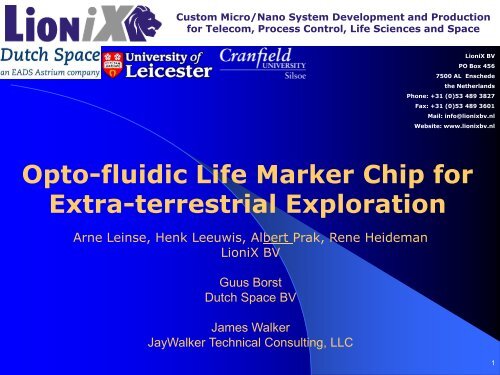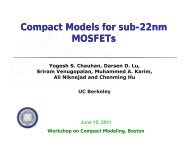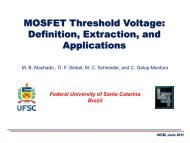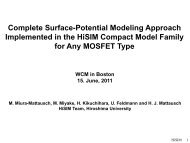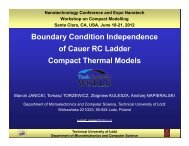presentation slides - TechConnect World
presentation slides - TechConnect World
presentation slides - TechConnect World
You also want an ePaper? Increase the reach of your titles
YUMPU automatically turns print PDFs into web optimized ePapers that Google loves.
Custom Micro/Nano System Development and Production<br />
for Telecom, Process Control, Life Sciences and Space<br />
LioniX BV<br />
PO Box 456<br />
7500 AL Enschede<br />
the Netherlands<br />
Phone: +31 (0)53 489 3827<br />
Fax: +31 (0)53 489 3601<br />
Mail: info@lionixbv.nl<br />
Website: www.lionixbv.nl<br />
Opto-fluidic Life Marker Chip for<br />
Extra-terrestrial Exploration<br />
Arne Leinse, Henk Leeuwis, Albert Prak, Rene Heideman<br />
LioniX BV<br />
Guus Borst<br />
Dutch Space BV<br />
James Walker<br />
JayWalker Technical Consulting, LLC<br />
1
Life Marker Chip<br />
• Goal<br />
– Search for molecular evidence of past or present life on Mars<br />
• How<br />
– In situ analysis using biosensing / bio-analytical technologies<br />
enabled by micro/nano systems technology<br />
The life marker chip for the Exomars mission 2
• Introduction to LioniX<br />
• Life Marker Chip on ExoMars rover<br />
• LMC analysis subsystem<br />
• LMC microfluidics<br />
• LMC integrated optics<br />
• Current challenges<br />
• Concluding remarks<br />
• Acknowledgements<br />
Overview<br />
3
LioniX Overview<br />
Develop/produce micro/nano-based products for (OEM) customers<br />
Customer space:<br />
•Telecom<br />
•Industrial Process Control<br />
•Life Sciences<br />
•Space Exploration<br />
Enschede, The Netherlands<br />
Dortmund, Germany<br />
Core technologies:<br />
•integrated optics<br />
•microfluidics<br />
•optofluidics (including surface functionalization)<br />
•MEMS<br />
LioniX offers ‘design for manufacturing’ and ‘horizontal integration’<br />
by partnering with foundries and suppliers of complementary<br />
technologies<br />
4
ExoMars Mission Schedule<br />
Life Marker Chip<br />
Courtesy of ESA<br />
5
Basis of the Life Marker Chip<br />
each site binds a different selective fluorescent biomarker dye<br />
parallel excitation (via integrated optics)<br />
parallel detection via camera<br />
Antibody microarray technology<br />
• attachment of thousands of probes<br />
in small area<br />
• small reaction volumes<br />
• higher reaction kinetics<br />
• potential for miniaturization and<br />
robotization<br />
Features<br />
1. Detect existent and extinct life<br />
2. Parallel multi-molecular detection<br />
3. No special external calibration<br />
4. Detection over broad molecular<br />
size range<br />
5. Sensitivity: From ppb to ppt<br />
6. Easy analysis<br />
7. Biotechnology industry support Typical image with one<br />
hundred different antibodies<br />
Courtesy of Mark Sims (LU) and<br />
Dave Cullen (CU)<br />
as well as positive and<br />
negative control<br />
Present-life biomarkers<br />
1. Whole cells,<br />
2. Cellular debris, biofilms<br />
3. Biopolymers<br />
Past-life biomarkers<br />
1. Aliphatic Hydrocarbons.<br />
2. Monocyclic hydrocarbons.<br />
3. Tricyclic hydrocarbons.<br />
4. Aromatic carotenoids.<br />
5. Hopanoids and other<br />
pentacycic triterpanes.<br />
6. PAHs.<br />
7. Lipids – Steroids.<br />
8. Porphyrins and<br />
maleimides.<br />
9. Aminoacids (aa) and<br />
nucleotides.<br />
10. Nucleotides and other<br />
metabolites<br />
11. Polymers<br />
6
• Space Flight Requirements<br />
Microsystem Challenges<br />
Compact, low mass, low reagent and energy consumption, robust<br />
(shock, radiation etc.)<br />
• Complicated fluidics in small chip sandwich<br />
Combination of innovative bellows pump and ‘hybrid’ selector valve<br />
• Leakproof bonding of microfluidic chip with integrated<br />
conductors and small tolerances<br />
New bonding technique<br />
• Integrated Laser-Induced Fluorescense system enabling<br />
dynamic/quantitive results<br />
Exploitation of planar waveguide evanescent field<br />
Flexible design features of TriPleX TM<br />
7
Analysis Sub-system<br />
Fluid I/F<br />
Fluid I/F<br />
preloaded with<br />
dry immunoassay chemistry<br />
Analysis system<br />
S-A1<br />
Conductivity sensor<br />
Assay<br />
chambers<br />
Single shot<br />
valve<br />
Buffer chamber<br />
V-A1<br />
0 0<br />
1<br />
1<br />
S-A2<br />
S-A3<br />
2<br />
2<br />
S-A4<br />
3<br />
3<br />
pad<br />
V-A3<br />
S-A5<br />
V-A2<br />
dissolution chambers<br />
optical I/F<br />
Bellows<br />
pump<br />
Late access I/F<br />
Pad, antibodies,<br />
lightsource<br />
Lightsource<br />
Front end electronics<br />
Power/data<br />
Mech.<br />
I/F<br />
Mech.<br />
I/F<br />
Thermal I/F<br />
multiple chambers enable assay of<br />
incompatible chemistries<br />
8
Assay chambers /<br />
Camera window<br />
Dissolution<br />
chambers<br />
Conductivity<br />
electronics<br />
Valve motor<br />
System Integration<br />
Fluid I/F<br />
Fluid I/F<br />
Analysis system<br />
S-A1<br />
Conductivity sensor<br />
Assay<br />
chambers<br />
Clamp for laserdiode<br />
LMC Analysis Subsystem<br />
Single shot<br />
valve<br />
Buffer chamber<br />
V-A1<br />
0 0<br />
1<br />
3<br />
V-A3<br />
2<br />
S-A2<br />
pad<br />
dissolution chambers<br />
S-A3<br />
S-A4<br />
S-A5<br />
2<br />
1<br />
3<br />
V-A2<br />
optical I/F<br />
Bellows<br />
pump<br />
Late access I/F<br />
Pad, antibodies,<br />
lightsource<br />
Lightsource<br />
Fluid storage, valve and pump<br />
Mech.<br />
I/F<br />
Mech.<br />
I/F<br />
Thermal I/F<br />
Front end electronics<br />
Power/data<br />
Rotary valve to<br />
control liquid flow<br />
Glass microfludics with channels,<br />
chambers and sensors<br />
Electronic Readout<br />
Laser<br />
Integrated Optics<br />
for Assay Readout<br />
9
Confluence of Microfluidics, Biotech, and Integrated Optics<br />
• Antibody microarray<br />
- competition assay format (3 chemistries)<br />
- predosed dried chemicals<br />
- single-use<br />
- 4 modules of 10x10 spots<br />
Analysis system<br />
Single shot<br />
valve<br />
Buffer chamber<br />
V-A1<br />
Fluid I/F<br />
S-A1<br />
Conductivity sensor<br />
1<br />
3<br />
V-A3<br />
2<br />
S-A2<br />
Fluid I/F<br />
S-A4<br />
Assay<br />
chambers<br />
0 0<br />
pad<br />
dissolution chambers<br />
S-A3<br />
S-A5<br />
2<br />
1<br />
3<br />
V-A2<br />
optical I/F<br />
Bellows<br />
pump<br />
Late access I/F<br />
Pad, antibodies,<br />
lightsource<br />
Lightsource<br />
Front end electronics<br />
Power/data<br />
Mech.<br />
I/F<br />
Mech.<br />
I/F<br />
Thermal I/F<br />
• Microfluidics based core system<br />
- micro channels: fluidic connections<br />
- micro chambers: reagents, array, buffer<br />
- micro sensors: electricial conductivity<br />
- planar optical waveguides: excitation of dyes<br />
- micro system integration: compact subsystem<br />
- hybrid selector valve<br />
• Integrated planar waveguides<br />
- Laser Induced Fluorescence (LIF)<br />
- excitation by ‘manifold’ substrate<br />
10
Microfluidic Chip<br />
1G-prototype<br />
52 mm<br />
16<br />
mm<br />
Dry reagent chambers<br />
Liquid front (EC) sensor<br />
Assay (reaction) chambers<br />
Buffer chamber<br />
Selection valve axis<br />
Liquid ports<br />
Contact pads<br />
EC sensors<br />
11
Buffer chamber<br />
(250 µm, 14.2 µL)<br />
Microfluidic Chip Sandwich Structure<br />
Etched micro<br />
channels (50 µm)<br />
chambers for<br />
reagent fiber pads<br />
(250 µm, 2.4 µL)<br />
Feed through<br />
(powder blasted)<br />
Specialized<br />
Wafer bond<br />
Fused silica<br />
top plate<br />
Fused silica<br />
bottom plate<br />
Viton seal<br />
Waveguide<br />
plate<br />
Selector<br />
valve axis<br />
Valve seat<br />
with channels<br />
Pre-processed<br />
sample input<br />
Assay chamber Clamping<br />
with reaction spots screws<br />
(0.8 µL)<br />
Waveguide<br />
with assay spots<br />
Total volume<br />
fluidic chip<br />
(32.7 µL)<br />
12
Fluidic Chip<br />
- electrodes and valve<br />
Valve rotor<br />
Fluidic chip with details of the access hole to the<br />
buffer chamber and a fluid front sensor<br />
Assembled valve<br />
13
Laser Induced Fluorescence (LIF) Detection<br />
Reaction Chamber<br />
<br />
<br />
<br />
array of 10x10 spots<br />
each spot functionalized for a specific target<br />
optically coupled with TriPleX TM waveguides<br />
Evanescent-field excitation<br />
of bound fluorescent dyes<br />
Parallel detection by camera electronics<br />
upper cladding is removed enabling strong<br />
evanescent field interaction<br />
14
TriPleX TM Waveguide Technology<br />
• low loss<br />
• small bending radius<br />
• good fiber coupling<br />
• transparancy from 400nm – 2500nm<br />
~100 nm<br />
2 m<br />
Si 3 N 4 : red layer<br />
SiO 2 : blue layer<br />
~1 m<br />
~1 m<br />
‘sensing’ geometry<br />
for Lab-on-a-Chip<br />
‘fiber-like’ geometry for data/telecom<br />
(polarization independent)<br />
Core of TriPleX TM :<br />
Si 3 N 4 / SiO 2 / Si 3 N 4<br />
‘design by geometry’<br />
15
Optical Chip and Fiber Connections<br />
• Multimode Interferometer<br />
• Core thickness tapering<br />
- 3 areas<br />
60/125 fiber<br />
(monitor)<br />
Monitor<br />
waveguide<br />
8 mW laserdiode,<br />
635 nm<br />
Sensing windows<br />
9/125 fiber<br />
(input)<br />
FAU<br />
(fiber array unit)<br />
Input<br />
waveguide<br />
MMI (1 x 11 splitter)<br />
Tapered area<br />
16
Concluding Remarks<br />
• Convergence of microfluidics-integrated optics-bio<br />
• Low-loss, wavelength-flexible waveguides enable<br />
compact, large-count fluorescent marker assay array<br />
• Surface functionalization is a key issue<br />
• Future developments in functionalization of microarrays<br />
will enable more application opportunities<br />
• LMC is an enabler for terrestrial applications<br />
17
Acknowledgements<br />
• Funding<br />
– Netherlands Space Office (NSO)<br />
– European Space Agency (ESA)<br />
Netherlands Space Office<br />
• LMC Team Leaders<br />
– Mark Sims, Leicester Univ. (UK)<br />
– Dave Cullen, Cranfield Univ. (UK)<br />
• LMC Instrument Team<br />
– Dutch Space (NL), Leicester University, Cranfield<br />
University, Magna Parva (UK), Kayser Italia, SSTL<br />
(UK), and Imperial College (UK)<br />
The life marker chip for the Exomars mission 18


